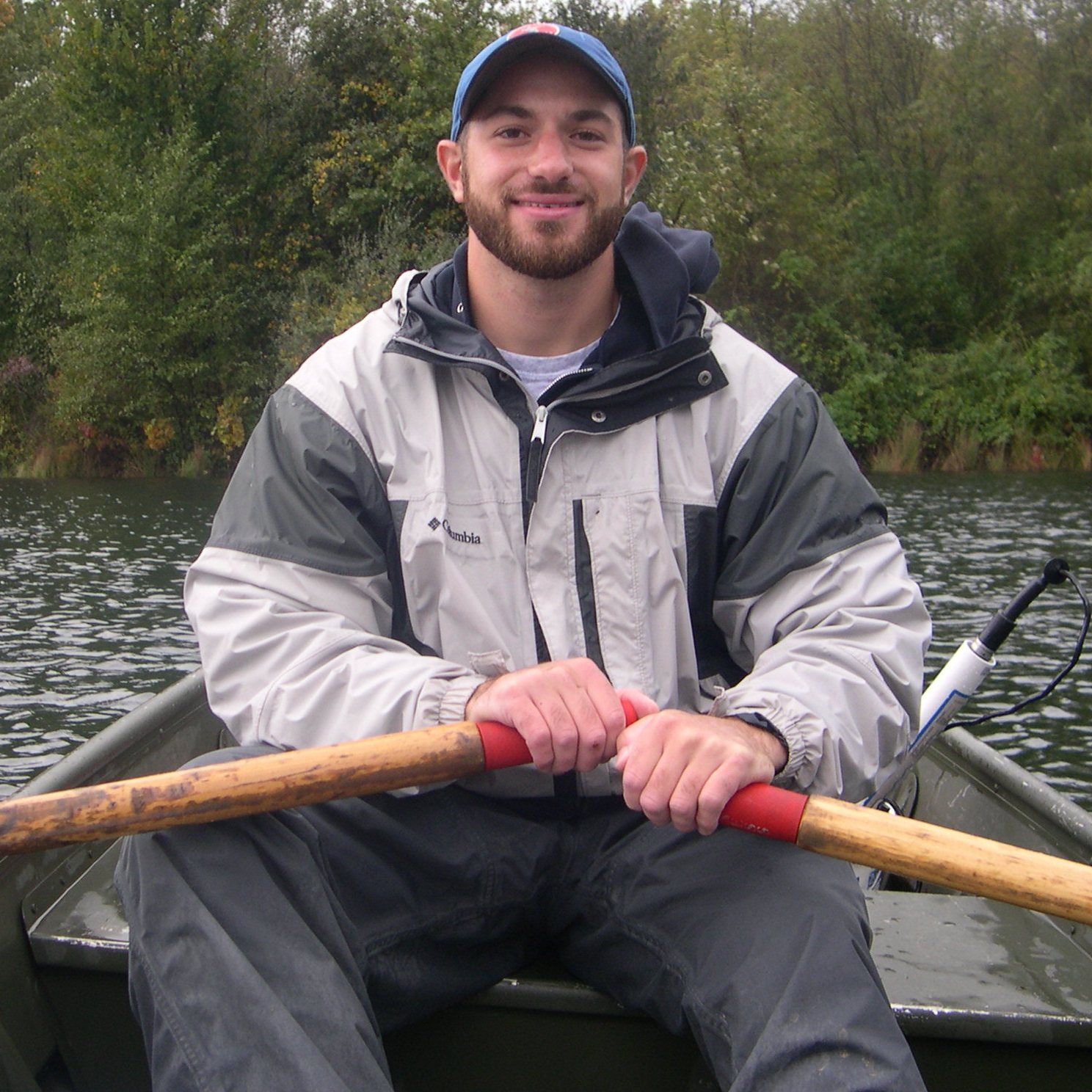
| David Civitello Postdoc |
||
|
Contact Information Office: SCA 322 Home page: https://sites.google.com/site/davecivitello/home Google Scholar: https://scholar.google.com/citations?user=FKV707cAAAAJ&hl=en EducationPhD.. Biology, Indiana University,, 2013 |
|
Research My research focuses on ecology, epidemiology, and physiology. I am specifically interested in the connections among environmental conditions, key traits of hosts and parasites, and disease dynamics in natural populations and communities. In particular, I am fascinated by factors that drive variation in parasite transmission and reproduction. My approach to science combines field surveys, experiments, and mathematical models. During my dissertation, I linked pollutants, nutrients, and host density to the magnitude and severity of fungal outbreaks in populations of the planktonic grazer, Daphnia dentifera. I am now shifting my focus to the human zoonotic parasites, Schistosoma spp., and their intermediate snail hosts. I am interested in building and testing body size- and resource- explicit models for Schistosoma epidemiology. Publications Cohen, J., Venesky, M., Sauer, E., Civitello, D., McMahon, T., Rohr, J. The thermal mismatch hypothesis explains outbreaks of an emerging infectious disease. In review at Ecology Letters. Rohr, J., Civitello, D., Cohen, J., Dell, A. A Global Framework for Estimating Acclimation and Thermal Breadth Predicts Risk from Climate Change. Submitted to Science. Strauss, A.T., Shocket, M.S., Civitello, D., Hite, J.L., Pencykowski, R.M., E., Duffy, M.A., Caceres, C.E., Hall, S.R. 2016. Habitat, predators, and hosts regulate disease in Daphnia through direct and indirect pathways. Ecological Monographs Cohen, J., Civitello, D., Brace, A., Feichtinger, E., Ortega, N., Richardson, J., Sauer, E., Rohr, J. 2016. Spatial scale modulates the strength of ecological processes driving disease distributions. Proceedings of the National Academy of Sciences, 113, E3359-E3364.(PDF+Supplement) Civitello, D., Cohen, J., Fatima, H., Halstead, N., Liriano, J., McMahon, T., Ortega, N., Sauer, E., Sehgal, T., Young, S., Rohr, J. 2015. Reply to Salkeld et al.: Diversity-disease patterns are robust to study design, selection criteria, and publication bias. Proceedings of the National Academy of Sciences, 112, E6262.(PDF) Civitello, D., Cohen, J., Fatima, H., Halstead, N.T., Liriano, J., McMahon, T.A., Ortega, C.N., Sauer, E., Sehgal, T., Young, S., Rohr, J.R. 2015. Biodiversity inhibits parasites: broad evidence for the dilution effect. Proceedings of the National Academy of the United States of America, 112, 8667-8671. (PDF) Civitello, D.J., Penczykowski, R.M., Smith, A.N., Shocket, M.A., Duffy, M.A., Hall, S.R. 2015. Resources, key traits and the size of fungal epidemics in Daphnia populations. Journal of Animal Ecology, 84 (4), 1010-1017 Wilson, C., Caughlin, T.T., Civitello, D.J. Flory, S.L. 2015. Combining mesocosm and field experiments to predict invasive plant performance: A hierarchical Bayesian approach. Ecology, 96 (4), 1084-1092 Halstead, N.T., Civitello, D.J., Rohr, J.R. 2015. Comparative toxicities of organophosphate and pyrethroid insecticides to aquatic macroarthropods. Chemosphere 135:265-271 Rohr, J.R., Civitello, D.J., Crumrine, P.W., Halstead, N.T., Miller, A.D, Schotthoefer, A.M., Stenoien, C., Johnson, L.B., Beasley, V.R. 2015. Predator diversity, intraguild predation, and indirect effects drive parasite transmission. Proceedings of the National Academy of the United States of America 112:3008-3013 Latta IV, L.C., Peacock, M., Civitello, D.J., Dudycha, J.L., Meik, J.M., Schaack, S. 2015. The phenotypic effects of spontaneous mutations in different environments. The American Naturalist 185, 243-252. McMahon, T.A., Sears, B.F*, Venesky, M.D., Brown, J.M., Deutsch, K., Halstead, N.T., Lentz, G., Tenouri, N., Young, S., Civitello, D.J., Ortega, N., Fites, J.S., Reinert, L.K., Rollins-Smith, L.A., Raffel, T.R., Rohr, J.R. 2014. Amphibians acquire resistance to live and dead fungus overcoming fungal immunosuppression. Nature 511:224-227 (cover photo and featured cover story) Civitello, D.J., Rohr, J.R. 2014. Disentangling the effects of exposure and susceptibility on transmission of the zoonotic parasite Schistosoma mansoni. Journal of Animal Ecology 83, 1379-1386. Civitello D.J., J.L. Hite, and S.R. Hall. 2014. Potassium enrichment stimulates the growth and reproduction of Daphnia.Oecologia 175, 773-780. Penczykowski, R.M., S.R. Hall, D.J. Civitello, and M.A. Duffy. 2014. Habitat structure and ecological drivers of disease.Limnology and Oceanography 59, 340-348 Civitello, D.J., S. Pearsall*, M.A. Duffy, and S.R. Hall. 2013. Parasite consumption and host interference can inhibit disease spread in dense populations. Ecology Letters. 16:626-634. Civitello, D.J., R.M. Penczykowski, J.L. Hite, M.A. Duffy, and S.R. Hall. 2013.Potassium stimulates fungal epidemics in Daphnia by increasing host and parasite reproduction. Ecology. 94:380-388. Civitello, D.J., P. Forys*, A.P., Johnson, and S.R. Hall. 2012. Chronic contamination decreases disease spread: a Daphnia-fungus-copper case study. Proc. Roy. Soc. B. 279:3146-3153. Duffy, M.A., J. Housley Ochs, R.M. Penczykowski, D.J. Civitello, C.A. Klausmeier, and S.R. Hall. 2012. Ecological context influences epidemic size and parasite-driven evolution. Science (Cover Article). 30:1636-1638. Bozarth, C.A., S.L. Lance, D.J. Civitello, J.L. Glenn, and J.E. Maldonado. 2011. Phylogeography of the gray fox (Urocyon cinereoargenteus) in the Eastern United States. Journal of Mammalogy (Cover Article). 92:283-294. Civitello, D.J., E. Rynkiewicz, and K. Clay. 2010. Meta-analysis of co-infections within ticks. Israel Journal of Ecology & Evolution (Invited for Special Feature). 56:417-431. Weston-Glenn, J, D.J. Civitello, and S.L. Lance. 2009. Multiple paternity and kinship in the gray fox (Urocyon cinereoargenteus). Mammalian Biology. 74:394-402 Civitello, D.J., S.L. Flory, and K. Clay. 2008. Exotic grass invasion reduces survival of Amblyomma americanum and Dermacentor variabilis ticks (Acari: Ixodidae). Journal of Medical Entomology. 6:867-872. Clay, K., O. Klyachko, N. Grindle, D. Civitello, D. Oleske, C. Fuqua. 2008. Microbial communities and interactions in the lone star tick, Amblyomma americanum. Molecular Ecology. 17:4371-4381. Steiner, F.E., R.R. Pinger, S.N. Vann, N. Grindle, D. Civitello, K. Clay, C. Fuqua. 2008. Infection and Co-infection Rates of Anaplasma phagocytophilum Variants, Babesia spp, Borrelia burgdorferi and the Rickettsial Endosymbiont in Ixodes scapularis (Acari: Ixodidae) from Sites in Indiana, Maine, Pennsylvania and Wisconsin. Journal of Medical Entomology. 45: 289-297.
|
||
